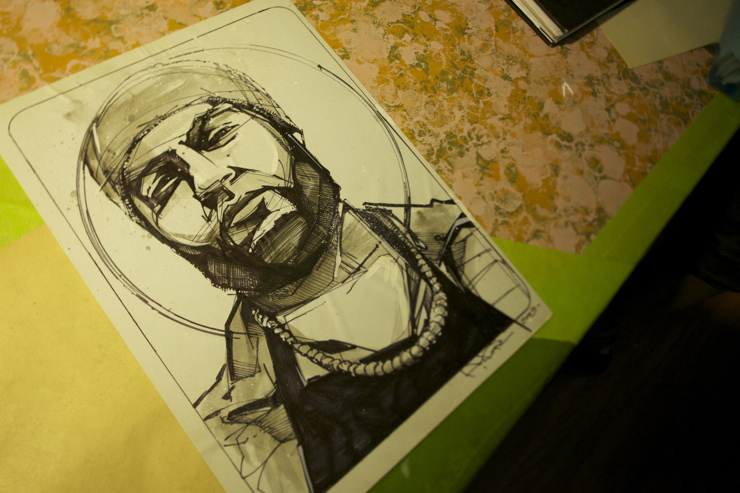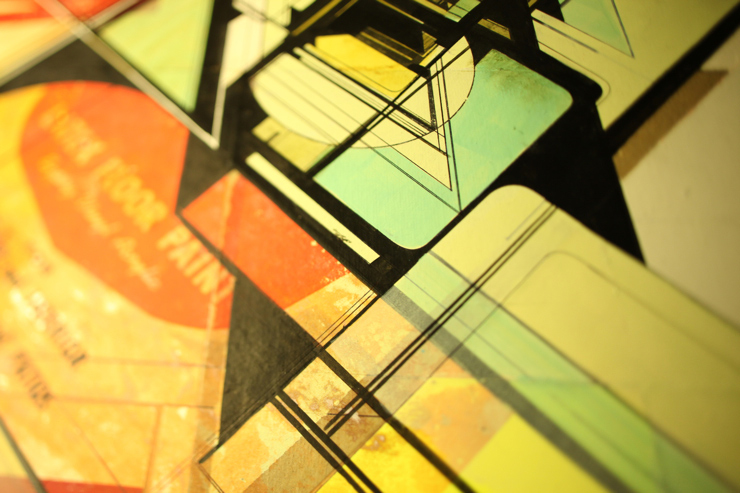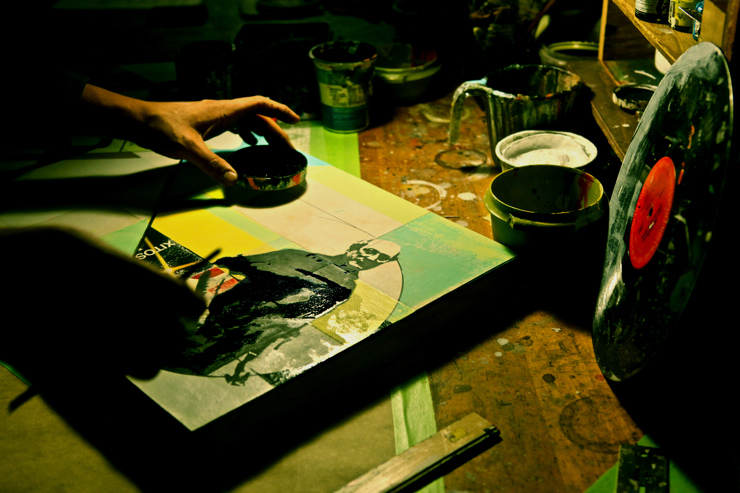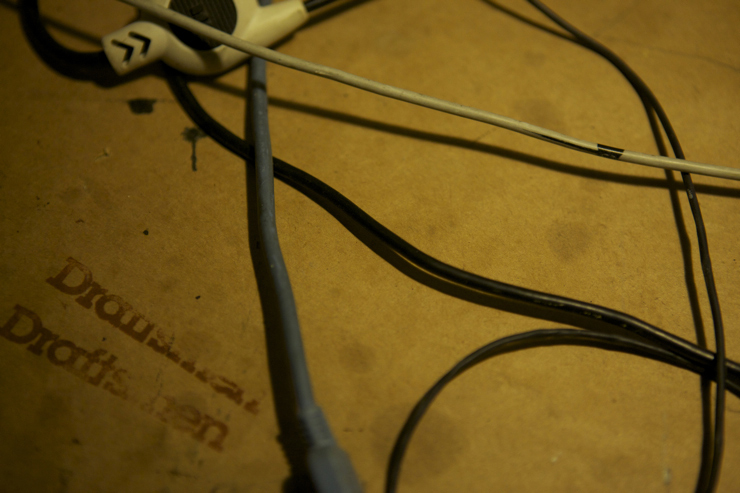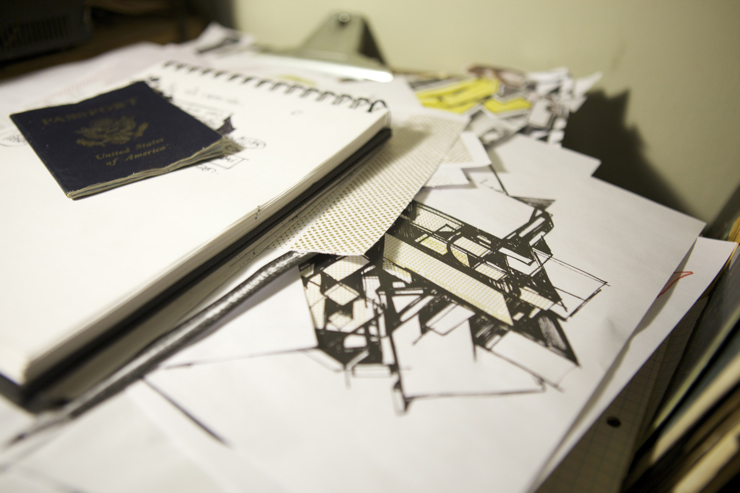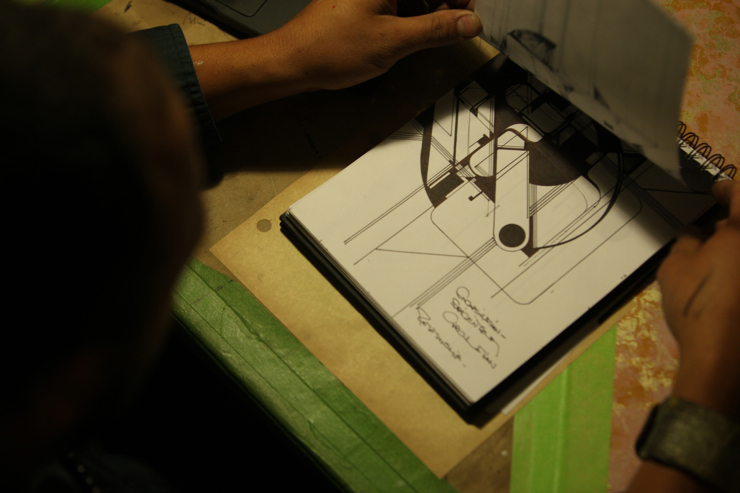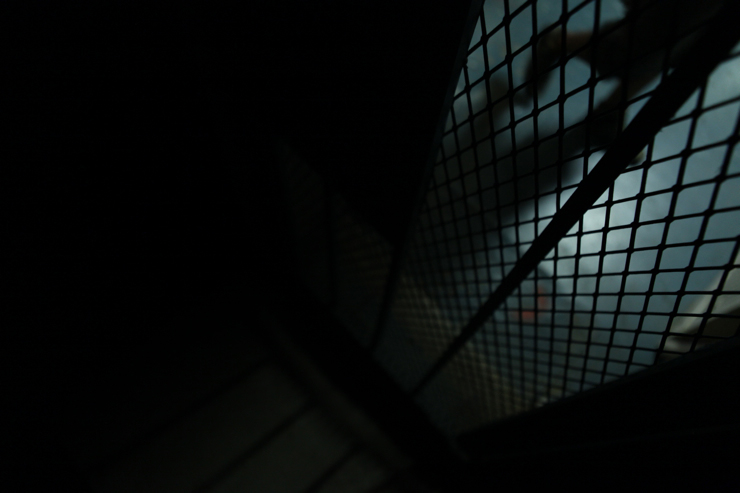Graffiti writer and fine artist. Old Skool Bomber. Wildstyle. Mid-Century Abstractionism. American Modernism. Choose One and Stick with it, right?
You find the evolution of artists of the streets can go in many different directions with time. As the current generation of wild teens and art school grads claim a hip-hop birthright to get up on public walls across cities everywhere, we are reminded of 1970s New York train-writing graff artists like Lee Quinones and Futura who eventually evolved their skills into galleries, private collections, museums. And they are only two. It has happened enough times now for it to be identified as a natural progression for some artists ‘of the street’, and in many cases, to incredible effect. It is a worthwhile point to consider if not labor over; the street has proven a valuable training ground for an increasing number of our great artists; With or without, and sometimes in spite of, our participation.
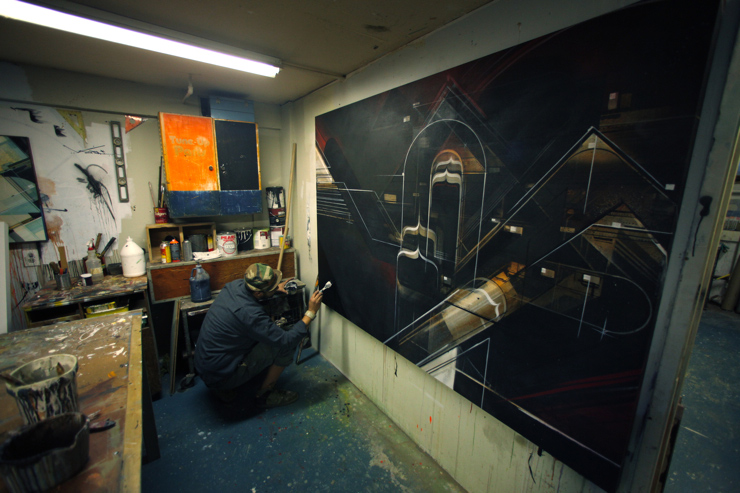 Augustine Kofie (photo © Todd Mazer)
Augustine Kofie (photo © Todd Mazer)
Augustine Kofie began as a writer in Los Angeles in the 1990s and has always had a deep love for illustration and linework. Today he has a studio doing markedly different work from what he developed on the streets – and it is a direct result of his evolution as an artist and as a person.
Todd Mazer recently visited the studio of Kofie and talks here about what he saw:
“Tucked away in the sleeping hills of Filipino town in Los Angeles, just a stones throw away from an Emergency Room entrance where Bob Dylan’s immortal words “He not busy being born is busy dying” are literal, you’ll find Augustine Kofie. This meeting of degradation and downfall with birth and uprising seem to be principle themes that play out in this ongoing story. It’s a story that eloquently eludes those who question the direction, proximity and order of the beginning to the end.
Kofie will be the first one to tell you that we are a product of our environment. Upon entering his work/living space it becomes nearly impossible to find the separation point between his environment and his work. A quick scan across the dimly lit room offers the realization that these aged manuals, endless sketchbooks and found artifacts are like records to a beat-maker and that Kofie is creating his own version of soul music on canvas”
~Todd Mazer
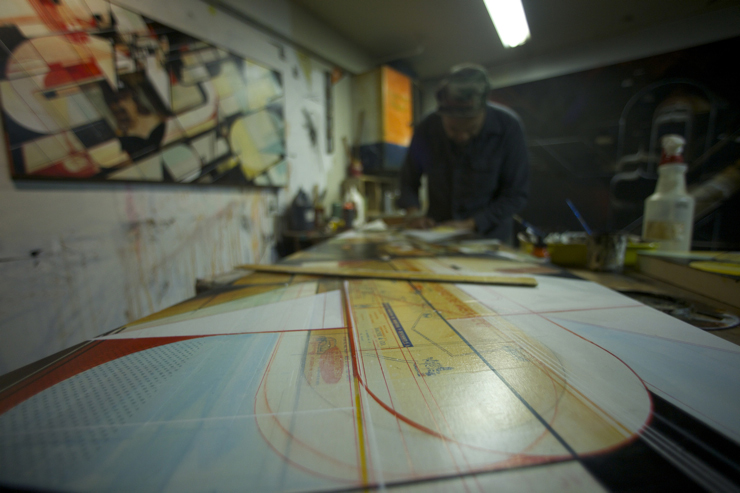 Augustine Kofie (photo © Todd Mazer)
Augustine Kofie (photo © Todd Mazer)
Kofie talked with Brooklyn Street Art about his work and his inspirations;
Brooklyn Street Art: The clean architectural lines and shapes in your work fit together as if they were a floor plan. Have you had experience designing buildings?
Augustine Kofie: None at all. I’m inspired by preliminary design, drafting, architectural renderings and pre production concepts revolving around visual futurist design. I wouldn’t be opposed to an actual build out based on my work at some point but it’s not where my heads at right now… sticking to what I know.
Augustine Kofie (photo © Todd Mazer)
Brooklyn Street Art: Why is it important to incorporate found items into your work, when you obviously could create them yourself.
Augustine Kofie: I’m taken by their texture, color and age, plus I enjoy the archeologist/ ‘digging in the crates’ aspect of collecting. Sampling is the best way to put it.. It is like finding a strange soundscape from a record or film, then twisting, manipulating and layering it with other found bits to create a new component, both audio and visual. They possess lost histories and past stories all their own so it feels appropriate and truthful to use such ephemera instead of recently produced papers. The up cycling and reinterpretations are endless.
Brooklyn Street Art: What kind of object catches your eye and forces you to bring it back to the studio?
Augustine Kofie: Usually outdated garage and office items from estate sales make me geek out. Anything that ‘contains’. Old wooden boxes, metal file boxes and hand made cabinets from an old mans garage workshop. Drafting based items. Paper wise, the more fatigued and yellowed the better but not to the point of crumbling. Engineering and accounting paperwork is nice as well. Yardsticks definitely get scooped.
Augustine Kofie (photo © Todd Mazer)
Augustine Kofie (photo © Todd Mazer)
Brooklyn Street Art Your work is vintage and futuristic – vintage in that jazz modernist warm way, and futuristic in its 1960s complex precision. Do you feel some nostalgia for that period and what does it represent for you?
Augustine Kofie: When I was a kid my parents played old jazz and soul records. This became the soundtrack to my life and I created my own perspective of a time-period that I only experienced as a child. That combined with the Futurist viewpoint of Syd Mead as well as the Futurist Movement set the foundation for what I do today and who I will become in the future.
Augustine Kofie (photo © Todd Mazer)
Brooklyn Street Art Your studio working environment really parallels the clean lines and warm tones of your work. Could you create this same work in a different place (like a chaotic and messy one for example), or is it not important at all?
Augustine Kofie: To me my studio is a place of comfort, meditation and inspiration. I prefer a ‘workshop’ environment over a living room setting. I have been working on my aesthetic for long enough that as long as I’m given paint and a surface then I could create a style that is mine, anywhere. The energy and execution of the art is always influenced by my surroundings, though.
Augustine Kofie (photo © Todd Mazer)
Augustine Kofie (photo © Todd Mazer)
Brooklyn Street Art: Your earlier graffiti contained foreshadowing of the abstract approach you are using now. At what point do your pieces stop being called graffiti and start being Street Art? Or does it matter at all to use terms like this?
Augustine Kofie: This is a strange place for me, this sort of limbo between titles. I just want to contribute my work as a man and as a whole, regardless of its contemporary title or standing. Confusing or not it is what it is.
My work and I are in constant progression. Evolution is mandatory. There is no seam that defines a beginning or ending to who I am and what I wish to produce. I do both the Graffiti and ‘art on the street’ depending on the moment and situation and especially moods. I’m a moody cat and I tend to gravitate to what I want to do to ease my restlessness. A different attention and energy is given to each form of expression here. Sometimes I want to blast on a crew production with classic characters/ letters & background scenarios. Other times I want to take a 20 year old can of outdated American spray-paint to a refused and abandoned surface and paint triangles, circles and lines without lettering, just getting loose on the foundations of line-work. I feel like Graff gave me a voice and I’ve contributed to this art form, now I have to contribute further and test my styles as well as change my own mindset and preconceived ideas of what this art form is as much as where its going.
Augustine Kofie (photo © Todd Mazer)
Augustine Kofie (photo © Todd Mazer)
Augustine Kofie (photo © Todd Mazer)
On Saturday March 5th Augustine Kofie will be part of a group show curated by Indigo at the Becker Galleries in Vancouver, Canada. To learn more details about this show click on the link below:
http://www.brooklynstreetart.com/theblog/?p=18278
Other Articles You May Like from BSA:
Black Heart in the Sun (Bishop 203) (photo Steven P. Harrington) Yo, check out the color! (JMR) (photo Jaime Rojo) Department of Parks Pool Rules: No. 4: Please check ...
MEETING OF STYLES had a huge event celebrating the 28th anniversary of the seminal book Spraycan Art by Henry Chalfant and James Prigoff in September in San Francisco. Organized by the community organ...
EARTH, AIR, FIRE, and WATER. And FUTURA 2000. These are the five elements. “Hey Guys!” he bellows from the doorway and invites us in. Futura (photo © Jaime Rojo) A non-stop full-voiced welcome fill...
This week BSA takes you to the French Polynesian Islands to see the new murals going up for this tropical island cultural festival called ONO'U Tahiti 2017. We're happy to bring you the daily events...
Our weekly focus on the moving image and art in the streets. And other oddities. Now screening:1. Gonzalo Borondo, "Settimo Giorno" 2. Graciela Iturbide in"Investigation" - Art in the Twen...
 BROOKLYN STREET ART LOVES YOU MORE EVERY DAY
BROOKLYN STREET ART LOVES YOU MORE EVERY DAY